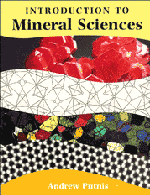Book contents
- Frontmatter
- Contents
- Preface
- 1 Periodicity and symmetry
- 2 Anisotropy and physical properties
- 3 Diffraction and imaging
- 4 Spectroscopic methods
- 5 The crystal structure of minerals – I
- 6 The crystal structure of minerals II – silicates
- 7 Defects in minerals, page 185 to 211
- Defects in minerals, page 212 to 238
- 8 Energetics and mineral stability I – basic concepts
- 9 Energetics and mineral stability II – solid solutions, exsolution and ordering
- 10 Kinetics of mineral processes
- 11 Transformation processes in minerals I: exsolution
- 12 Transformation processes in minerals II: structural phase transitions
- Index
9 - Energetics and mineral stability II – solid solutions, exsolution and ordering
Published online by Cambridge University Press: 05 June 2012
- Frontmatter
- Contents
- Preface
- 1 Periodicity and symmetry
- 2 Anisotropy and physical properties
- 3 Diffraction and imaging
- 4 Spectroscopic methods
- 5 The crystal structure of minerals – I
- 6 The crystal structure of minerals II – silicates
- 7 Defects in minerals, page 185 to 211
- Defects in minerals, page 212 to 238
- 8 Energetics and mineral stability I – basic concepts
- 9 Energetics and mineral stability II – solid solutions, exsolution and ordering
- 10 Kinetics of mineral processes
- 11 Transformation processes in minerals I: exsolution
- 12 Transformation processes in minerals II: structural phase transitions
- Index
Summary
The existence of solid solutions plays a major role in determining the composition of minerals. The range of composition over which a mineral structure is stable depends very much on the temperature, high temperatures allowing a greater flexibility in atomic substitution. In this chapter we will first describe how the formation of solid solutions affects the free energy of a mineral, and hence its thermodynamic relationship with other minerals in a rock. We then consider how this free energy changes as the temperature is decreased. In this way we can build up a thermodynamic description of the behaviour of solid solutions, leading to an understanding of how solid solutions behave on cooling. Again the emphasis is on the tendency for disorder at high temperatures, giving way to order at low temperatures. The concepts discussed in this chapter are not only very important in minerals which have formed at high temperatures and then cooled, but also in low temperature minerals where solid solutions and disordered states can exist metastably.
Solid solutions
Most natural mineral groups can exist over a range of chemical compositions which are generally specified in terms of fixed composition end-members. Thus olivine (Mg,Fe)2SiO4 can have any composition between the end-members forsterite (Mg2SiO4) and fayalite (Fe2SiO4) by substituting Mg and Fe on the M1 and M2 octahedral sites. Olivine is therefore a substitutional solid solution. In the description of mineral structures in Chapters 5 and 6 there were many examples of such solid solutions.
Information
- Type
- Chapter
- Information
- An Introduction to Mineral Sciences , pp. 275 - 308Publisher: Cambridge University PressPrint publication year: 1992
Accessibility standard: Unknown
Why this information is here
This section outlines the accessibility features of this content - including support for screen readers, full keyboard navigation and high-contrast display options. This may not be relevant for you.Accessibility Information
- 1
- Cited by
